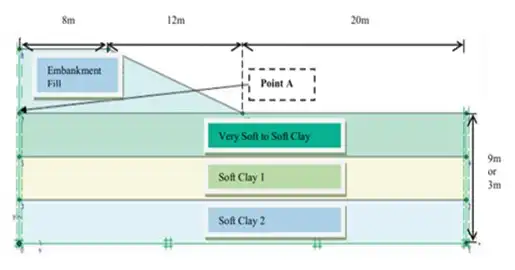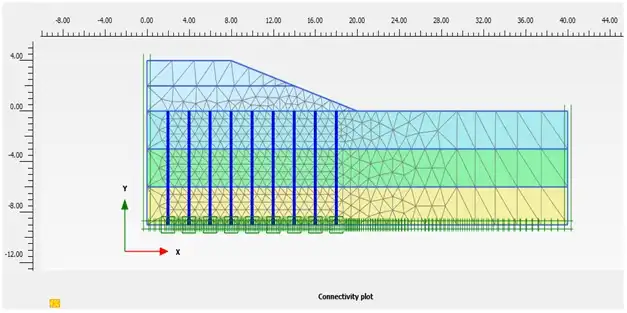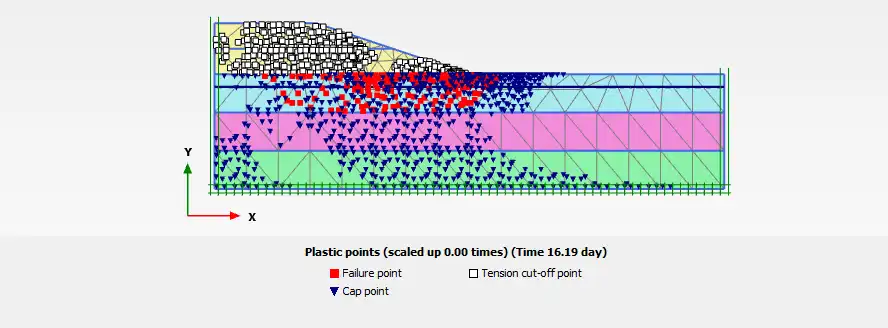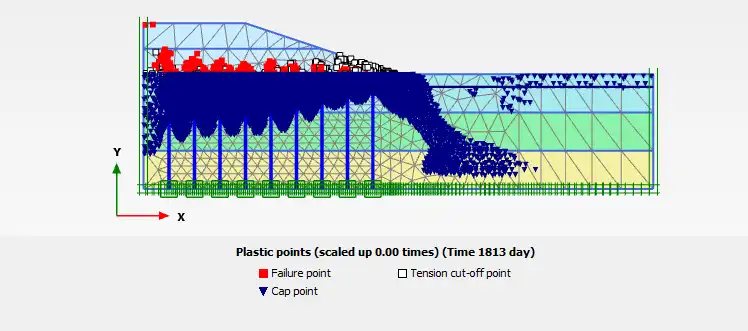

A comparision study is carried out to analyze the deformation characteristics of a 4 m high embankment resting on layered soft soil strata with and without pile reinforcement using numerical simulation on PLAXIS 2D. The result showed that the simulation failed when the embankment was resting on soft soil without any reinforcement. Inclusion of pile supports underneath embankment resting on soft soil made the structure stable and decreased settlement. The settlement decreased to 0.3052 m(reinforced soil) from 2.539 m (unreinforced soil). The critical failure points got constrained to the soft soil lying amidst the pile supports. The reduction in settlement and localization of failure points after the inclusion of pile reinforcement is attributed to the soil arching effect in soft clay.
INTRODUCTION
Due to increasing population and decrease in the availability of land, investigations regarding construction on soft soil have become an utmost necessity. Since the soft soils deposits are having extremely low bearing capacity, excessive settlement during and post construction- alternatives are required to enhance the properties of these soils. Pile support for embankment is adopted when total replacement of soft soil is not a cost effective solution or other ground improvement techniques are not efficient enough.
Many researchers have proposed various methods to improve the properties of soft soil. Esmaeli et al. prepared experimental models of a high embankment with and without micro piles and concluded that the bearing capacity of soft soil was improved by 65% and factor of safety increased by 30%. Borges and Almeida simulated sidewall technique coupled with prefabricated vertical drains (PVD’s) and performed parametric study to analyze impact of wall’s bending stiffness on behavior of embankment. Fırat et al. investigated the effect of soil type, height and water table level on embankment stability. Low water table and medium semi stiff clay gave higher factor of safety. Wu et al. studied the performance of a 40 m high embankment built on soft soil reinforced with (pre-fabricated high strength concrete) PHC piles using ABAQUS 3D model. The research concluded that maximum horizontal displacement occurred in between the toe and center line of embankment and soil starts flowing around piles resulting in bending failure of piles.
In this paper, the effect of pile supports in soft soil underneath an embankment has been studied to observe the settlement and location of failure points by carrying out a finite element simulation.

NUMERICAL SIMULATION
In order to carry out comparison between the deformation patterns of an embankment resting on soft soil with and without pile supported reinforcement, a two- dimensional plane-strain numerical model was simulated using a commercially available software PLAXIS 2D.
The problem consisted of a 4m high embankment resting on soft ground underlain by 3 major layers of soil: 3m very soft to soft clay (top layer), 3m soft clay (middle layer – named as Soft Clay 1) overlying 3m soft clay (bottommost layer – named as Soft Clay 2). The contours of simulations were set as xmin = 0.0 m, xmax = 40.0 m, ymin = -9.0 m and ymax = 4.0 m. The pile supports were modeled as plate elements. The depth of pile supports was taken upto base depth of 9m with 2 m center to center space. Regarding the drainage boundary conditions, the water table was assumed to be located at 1m below ground level.
The soft clay stratums were modeled using Modified Cam Clay (MCC) model as it is considered as the most applicative constitutive model. The embankment fill material was modeled using the Mohr-Coulomb (MC) failure criterion and the pile supports were treated as a continuous and linear elastic material. The parameters as reported by Kasim et al. (2013)were considered for simulation by PLAXIS 2D software and are summarized in Table 1.
The problem was medium meshed in order to study the deformation characteristics and consolidation analysis was carried out to observe the settlement pattern and analyze the development and dissipation of excess pore pressure in saturated soft clay stratums.

Table 1: Parameters considered in the simulations (Kasim et al. (2013)
| Description | Embankment fill | Very soft clay | Soft clay (1) | Soft clay (2) | Pile |
| Model | Mohr-Coulomb | Modified Cam Clay | Modified Cam Clay | Modified Cam Clay | Linear elastic |
| Drainage | Drained | Undrained (A) | Undrained (A) | Undrained (A) | – |
| ϒunsat (kN/m3) | 15 | 8.19 | 12.55 | 10.76 | – |
| ϒsat (kN/m3) | 18.90 | 12.82 | 14.72 | 14.27 | – |
| kx (m/day) | 4.32E-3 | 3.825E-4 | 1.3E-3 | 2.125E-4 | – |
| ky (m/day) | 2.16E-3 | 1.912E-4 | 6.5E-4 | 1.062E-4 | – |
| λ* | – | 0.075 | 0.057 | 0.068 | – |
| κ* | – | 0.025 | 0.032 | 0.03 | – |
| M | 1.2 | 1.2 | 1.2 | 1.2 | – |
| c’ (kN/m2) | 10 | 7 | 10 | 5 | – |
| Φ’ | 30 | 27 | 30 | 30 | – |
| υ’ | 0.3 | – | – | – | 0.3 |
| Rinter | 1 | 1 | 1 | 1 | 1 |
| EA (kN/m) | – | – | – | – | 7.5E6 |
| EI (kN-m) | – | – | – | – | 1E6 |
| E (kN/m2) | 8500 | – | – | – | – |
RESULTS AND DISCUSSION
- Simulation 1: Numerical simulation for an embankment resting on layered soft soil without any reinforcement. (Fig 2)

- Simulation 2: Analysis of an embankment resting on layered soft soil with piled reinforcement up to base (9 m). (Fig 3)

Deformation analysis:
As depicted in Fig 4, inclusion of pile supports reduced the settlement in the soft soil to a maximum value of 0.3052 m (Fig 4b) as compared to 2.539 m (Fig 4a) without pile supports. The intensity of settlement also reduced with inclusion of pile supports in soft soil as the downward movement of the embankment is restricted by the shear resistance from the soil above the pile supports. Due to this shear resistance, the stress coming on the soft soil is reduced and the stress acting on the pile supports is increased. This load transfer phenomenon is called ‘‘soil arching”. This soil arching effect further reduced the settlement in pile supported embankment resting over soft soil.


Fig4: Deformation analysis of the simulations.
Location of failure points:
As depicted in Fig 5, the critical failure points occurred within the first layer of soft stratum in case of embankment resting on soft soil without any support and the simulation failed within the first phase of staged construction (Fig 5a). Confinement of failure points between the pile supports was observed in case of pile supported embankment (Fig 5b). This was because the foundation soil lying in between the pile supports tends to settle more due to the stiffness difference of soft soil from that of pile supports. The load from the embankment fill is taken by the shear resistance from the soil above the pile supports and hence the critical failure points are observed.


Fig 5: Location of failure points in the simulations.
CONCLUSION
This paper presented the results of numerical simulation that were done using PLAXIS 2D to carry out a comparision study of embankment resting on layered soft soil strata with and without pile reinforcement.
The main results concluded from the given study are summarized as follows:
- Inclusion of pile reinforcement upto base in embankments resting on layered soft soil made the structure stable and decreased the maximum displacement value to 0.3052 m. The deformation was 2.539 m within the first phase of staged construction without any reinforcement.
- The location of failure points got confined to the space between the pile reinforcement indicating the piles resisting the load through shear and effect of soil arching in soft soil making the structure more stable. The simulation failed when embankment rested on layered soft soil strata without any reinforcement.
REFERENCES
- Borges, J.L. and Almeida, F. “Sidewalls and PVDs below embankments on soft soils -Three-dimensional analysis by FEM.” Geotechnique Journal.
- Esmaeili, M., Nik, M.G. and Khayyer, F. “Efficiency of micro piles in reinforcing embankments.” Institution of Civil Engineers-Ground Improvement, (167), 122-134.
- Fırat, S., Işık, N.S. and Yamak, S. “Effect of height and water table level on stability analysis of embankments.” (3rd International Sustainable Buildings Symposium (ISBS), Geotechnique Journal.
- Kasim, F., Marto, A., Othman, B.A., Bakar, I. and Othman, M.F. “Simulation of Safe Height Embankment on Soft Ground using Plaxis.” Asia-Pacific Chemical, Biological & Environmental Engineering Society.
- Wu, J.T., Ye, X., Li, J., Li, G.W. “Field and numerical studies on the performance of high embankment built on soft soil reinforced with PHC piles.” Computers and Geotechnics.

